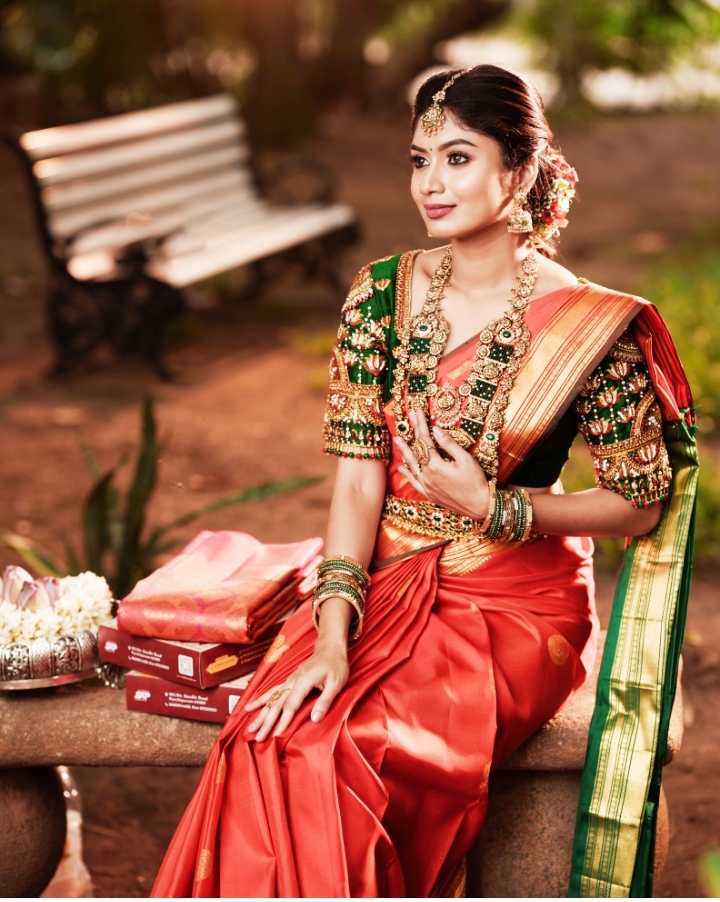How Herballife consider as No. 1 Nutrition food in the World
November 2, 2025
November 4, 2025,9:57:49 PM

Bangalore 26th July 2024:
Varahi Lakshmi Silks Presents the one & only Pure Kanchipuram Sarees on different verities in Various New Collections, starting 26th July 2024 till 28th July 2024. Varahi Lakshmi silks will launch their first exclusive exhibition in Bangalore with pure silk wedding sarees at Kanchipuram’ and offer genuine quality Kanchipuram sarees, Aranisarees, Dharmavaram sarees, Uppada sarees and handloom sarees.
![]()
Varahi Lakshmi silks owns more than 1000 handloom weaving machines, their exclusive collection is available at wholesale pricing, eliminating the middleman and passing on the price benefits to the consumers as they serve them directly.
![]()
The exhibition will be an abode for the rare and eternal pure Kancheepuram Sarees, Aarani Sarees, Banaras Sarees, Dharmavaram Sarees, Uppada Sarees, Handloom Sarees, Real Jari Kota Sarees and Designer Sarees. Each saree purchased will receive the Silk mark and purity certificate to endorse that it is genuine.
![]()
Sarees are available right from Rs.500 to Rs. 2 lakh. Day & Date: Friday, 26th July 2024 Time: 10 am till 8:00 pm
Venue: Jagadish Hotels (Basement of Italian Bake House) New No: 51, Old No.664, 11th Main Road, 4th Block, Jayanagar, Bengaluru – 5600011 ENTRY FREE ALL ARE WELCOME !!! Media Contact: SPIRE PR HETAL – 9986073035 / Harish Kumar – 9535112332
![]()
History and Origins of Kanjeevaram Sarees
The origins of the Kanjeevaram silk sari can be traced back to Hindu mythology. According to legend, the Kanchi Silk Weaver is a descendant of Sage Marcanda, known as the Gods' Master Weaver.
The world-famous Kanchipuram Saree weave dates back 400 years and is located in the little town of Kanchipuram (Tamil Nadu). During Krishna Devalaya, art was born (of the Vijayanagar Empire). Devangas and Saligers, two big weaving groups from Andhra Pradesh, have relocated to Kanchipuram. Silk saris with images of inscriptions and figures seen in temples around the area were created using superior weaving skills.
In South India, the Kanchipuram Silk Saree, also called as Kanjivaram Saree, is frequently compared to the Benarsi Saree. Because of its thick fabric and bright gold colours, this sari is suitable for formal gatherings and celebrations. Kanjeevaram or Kanchipuram silk saris are the perfect choices if you're seeking an elegant ethnic alternative.
Saree has become a must-have for women in traditional ceremonies, weddings, and other events in South India.
![]()
Pure mulberry silk is used to weave the Kanchipuram silk sari. Even though silk is native to southern India, pure gold and silver zari is native to Gujarat. Then, the silk thread used to weave saris is steeped in rice water and dried in the sun before use to increase both thickness and rigidity. Once done, the weaver uses the silk thread with a fine silver wire and finishes it with the gold thread to complete the technique.
To give it a robust feel, the warp frame used to weave this fabric includes 240 holes in the warp and around 60 holes in the weft with 250-3000 threads. The saree's pallu, border, and body are usually knitted individually and then stitched together extremely precisely and cleanly, giving the Kanchipuram saree its traditional look.
![]()
Characteristics of Kanjeevaram Silk Sarees
Because of the huge colour and design variances between the body and the pallu, the weaver weaves them separately before combining them. The zigzag pattern (known as Pitni) can be seen where the body meets Pallu.
It's also typical to weave the three sari borders individually before putting them together. When the sari tears, the three connections (known as korai) are established precisely so that the borders do not weaken.
The fabric is highly tough and durable since the Zari is formed by twisting three silk threads with silver wire. This can, however, add weight, and a Kanjeevaram sari can weigh up to 2 kilogrammes.
The Colours of Kanchipuram
Saree is recognised for her vibrant colours and eye-catching patterns, mostly influenced by the books and figurines seen in many of the village's temples. Saree's pallu and body are different colours and designs, so expect a wide range of tints.
![]()
The Motifs found on Kanchipuram Sarees
Kanchipuram's Silk Saree has faithfully included temple motifs and mythical legends into its creations from its debut. The perimeter of the
The body of the Saree features pyramid-shaped temple designs, checks, stripes, floral buttons etc. however, the motifs have changed over the years and now consist of fruits, animals, birds, the sun, the moon, and even mythological stories have replaced conventional and highly appreciated striped or gold dot designs over the years.
The Varieties of Kanchipuram Silk Saree
The Kanchipuram silk sari was initially woven in a 9-yard weave, but more practical 6-yard weaves have been introduced throughout time. The original gold and silver shavings have been replaced by metal or copper shavings, maintaining the texture's lustre while lowering expenses. However, if you require the original, you must ensure that the Zari work is genuine.
![]()
The Current State of Kanchipuram Sarees
Since 2006, the government has designated the Kanchipuram sari as a geographical designation. This is confirmation of authenticity, and it has helped the Kanzi Balaam Silk Saree sell more. Approximately 5,000 families are currently employed in the industry, supported by 15 silk and cotton factories and 60 dyeing companies.
In 2008, a Tamil film titled Kanchivaram was released about weavers, which helped bring their issues to the general public's attention. The government also implemented a programme to stimulate the electronic marketing of local weavers.
Thirteen e-commerce companies have teamed up with the Development Committee (Handlooms) to sell hand-woven goods created by the weavers themselves. This implies that if you buy a Kanchipuram sari online, you can get the cloth directly from the weaver and get the finest of the finest Kanchipuram.
© 2024 Iconsofindianbusiness.com. All Right Reserved.